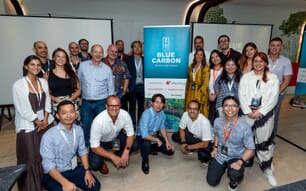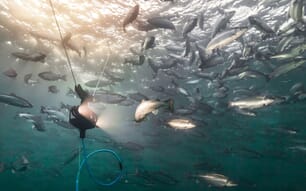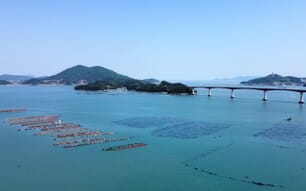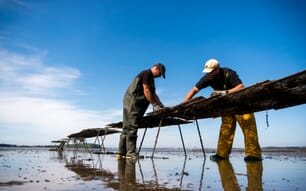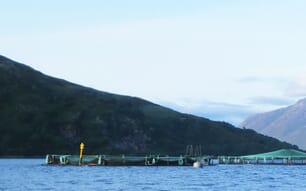
The dome allows the salmon to fill their swim bladders, even in the submerged position © Akva Group
While conventional open-net cages remain the backbone of finfish production, a growing share is expected to come from new farming approaches. These include both land-based technologies, such as RAS, which allow for more controlled culture conditions, and sea-based technologies, such as (semi-) closed containment systems, submersible cages and offshore farms. Both fields aim to address industry pain points such as parasites, algal blooms and climate risks, while enabling production in new regions. However, this article will concentrate on a variety of novel farming systems at sea.
Innovation driven by the salmon sector
Growing environmental challenges, stricter regulations and rising consumer demand for responsibly produced seafood are placing pressure on farmers to rethink their production methods. Nowhere is this more visible than in the salmon farming industry, which remains the flagship sector for developing and testing new technologies.
The industry’s number one pain point – sea lice – imposes high costs and raises significant welfare concerns, with salmon suffering both from the parasite itself and from indirect effects of treatments. To address this, producers are demonstrating an increasing interest to move toward preventive lice control measures, mainly with the aim to create spatial or physical barriers between the parasite and the fish. Major salmon producers are directing their investments and R&D efforts toward identifying and trialling the most promising technologies to address this challenge.
In terms of new farming approaches, leading companies such as Lerøy and Mowi have expressed a growing interest in submersible aquaculture.
Lerøy highlighted its current focus on two types of new sea-based production technologies: submersible and semi-closed systems. This so-called 'shielding approach' has shown promising results, reducing mortality and lowering the need for lice treatments. According to the company's Q2 presentation, 44 percent of harvest volumes in Lerøy Midt and 49 percent in Lerøy Sjøtroll came from submerged farming systems in Q2 2025. Looking ahead, Lerøy aims for around 35 percent of its total harvest volume to come from shielding technologies, including the use of laser delousing, as well as submersible systems and semi-contained farming.
In parallel, leading salmon farmers are also focusing on the post-smolt strategy, where fish are grown to a larger size before they are transferred to the grow out system at sea. While a strong focus and investment for post-smolt production currently lies in land-based facilities, semi-closed containment systems at sea are also being tested as part of the post-smolt strategy.
Offshore farming is another area that is being explored by the Norwegian salmon industry. Salmar's Ocean Farm 1 was one of the first pilot projects, operating “semi-offshore” since 2017. However, early trials as well as scenario analysis have demonstrated that developing offshore farming requires substantial investments across the entire value chain. The recent announcement by the Norwegian government to open three offshore areas for fish farming is an important step forward, but to actually start large-scale offshore farming in these areas will demand massive investments. Meanwhile farmers have voiced concerns about moving ahead until the government clarifies both the tax framework and the regulatory rules for offshore aquaculture.

© Ovum
Understanding the variety of today’s sea-based farming approaches
(Semi-) closed containment systems
Closed containment systems (CCS) are designed to provide better control over farming conditions by limiting direct interaction between farmed fish and the surrounding environment. These systems are generally designed for nearshore or sheltered farming areas, as they place higher drag forces on moorings compared to traditional cages.
Currently, the industry distinguishes between two main types:
- Fully enclosed systems with impermeable walls and – usually – tops. Exchange with the environment is limited to a deep-water intake. Companies involved in the development of these systems include FishGlobe, Ovum and Bluegreen Group.
- Semi-closed containment systems typically feature open-topped designs – resembling conventional pens from above but deploying barriers below the surface (e.g. PVC bags). The designs can vary: some are partially permeable or allow water exchange at the bottom of the enclosure. Companies working on these solutions include FiiZK, Aquafarm and Seafarming Systems.
These systems tend to require advanced support technologies and automated workflows. Equipment such as cameras, sensors, pumps, and cleaning systems are essential for effective monitoring and for managing critical parameters, including oxygen, waste, water flow, and CO₂ removal.
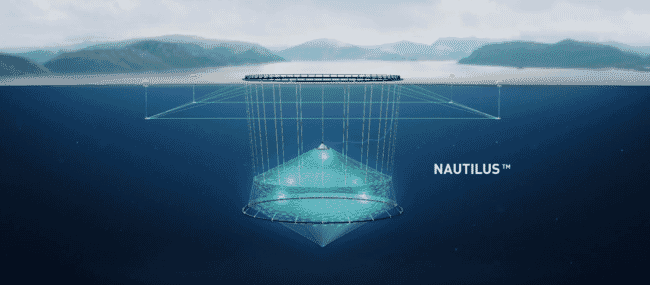
© Akva Group
Submersible aquaculture systems
Submersible aquaculture refers to farming systems in which the fish containment units, typically net-like structures, are submerged below the water surface, temporarily restricting fish access to the surface for either short or long-term periods. Various design models are available – some are fully submerged (see below), while others feature a floating ring that remains at the surface, with only the fish containment unit (net) submerged. Fully submerged cages may be better suited for exposed environments, whereas keeping a floating ring at the surface can provide support for maintenance and operational tasks. Companies developing submersible systems include Akva Group, Scale AQ, Innovasea and Badinotti Group.
Types of submersible systems:
- Submersible nets: the main frame (ring), grid mooring lines and buoys remain on the surface, while only the net is submerged.
- Submersible pens: can be raised or lowered entirely, except for infrastructure such as marker buoys.
- Fully submerged systems: similar to submersible pens, but designed for the entire infrastructure, including mooring lines, to be lowered beneath the surface.
The choice between long-term and short-term submergence strategies depends on the species being farmed and the specific farming challenges. For example, in salmon farming, long-term submersion is targeted to minimise exposure to sea lice in the upper water layers, however, long-term submersion requires advanced supportive technologies, including monitoring equipment (sensors, cameras, etc), underwater feeding systems, lighting, and, in the case of salmon, artificial air domes to allow them to top up their swim bladders.
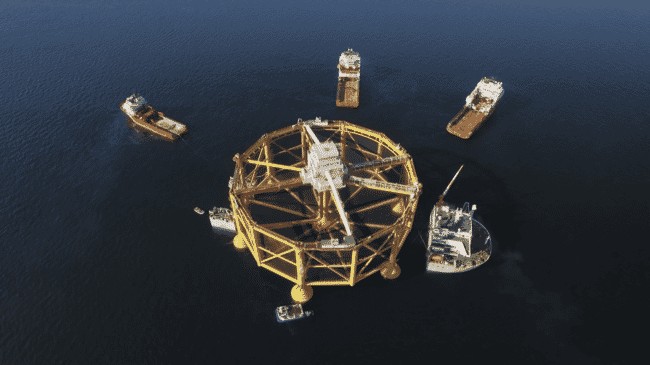
© SalMar
Large-scale offshore farming systems
The search for expansion opportunities into new regions is driving the development of large, robust, and complex facilities capable of withstanding harsh offshore conditions. These kinds of systems rely on advanced ocean engineering expertise, including hydrodynamics, structural analysis, and risk management together with specialised logistics. In Europe, large-scale offshore farming projects have been mainly led by established salmon industry players, targeting high-volume production. However, adoption faces challenges, including high capital requirements and regulatory uncertainties. Besides Norway, China is pioneering the development of these larger offshore projects.
A variety of system concepts are being tested or developed:
- Column-stabilised systems: rigid steel frameworks with circular support columns, designed for high-energy environments; some adopt semi-submersible designs (e.g., SalMar’s Ocean Farm 1).
- Ship-shaped systems: structures tailored for exposed offshore conditions which can change positioning (e.g., Nordlaks’ “Jostein Albert”).
- Other innovative concepts include the co-location of wind farms and offshore aquaculture, such as the partnership between Sweden’s Freja Offshore and Norway’s SubFarm to build fish farms in the Mareld floating offshore wind farm.
Considering the harsh environments these systems are intended to operate in, innovative supporting technologies are needed to minimise production interruptions, ensure good fish welfare and enhance work safety. These include tools already used in smart farming approaches for conventional pen systems but may require adaptation to withstand extreme conditions and meet the unique operational demands of offshore farming.
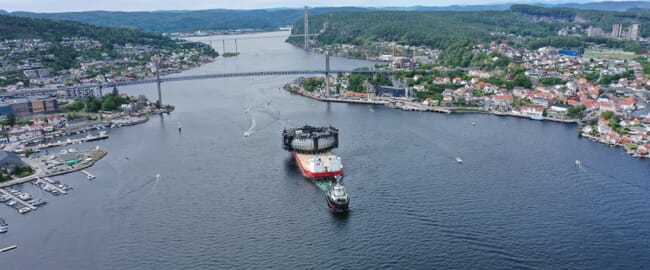
© BlueGreen
Opportunities and challenges
Closed and semi-closed containment systems offer greater control over the farming conditions, potentially mitigating issues such as sea lice, diseases and escapes. Submerged aquaculture enables the use of deeper water layers, avoiding many surface-based challenges, while offshore systems create opportunities for expansion into new farming areas.
Although these novel farming systems hold the potential to address many of the major challenges facing conventional net-pen farming, their impact on fish health, welfare, sustainability, operational efficiency and cost competitiveness still need to be fully demonstrated, as most of these technologies remain under development. Additionally, the emergence of new challenges, associated with farming in new regions or water layers, must be carefully assessed.
Realising the full potential of these new approaches will require substantial financial investment to support further development, deployment and operational scaling, as well as a robust regulatory framework.
If you’d like to learn more about emerging farming systems and explore the current challenges shaping the future of aquaculture, get in touch with us at Hatch Blue Consulting.

